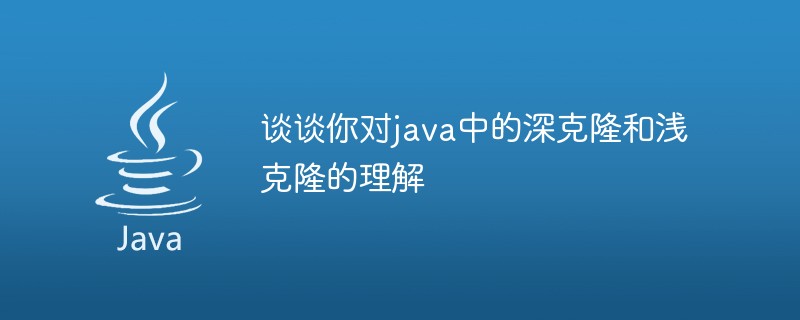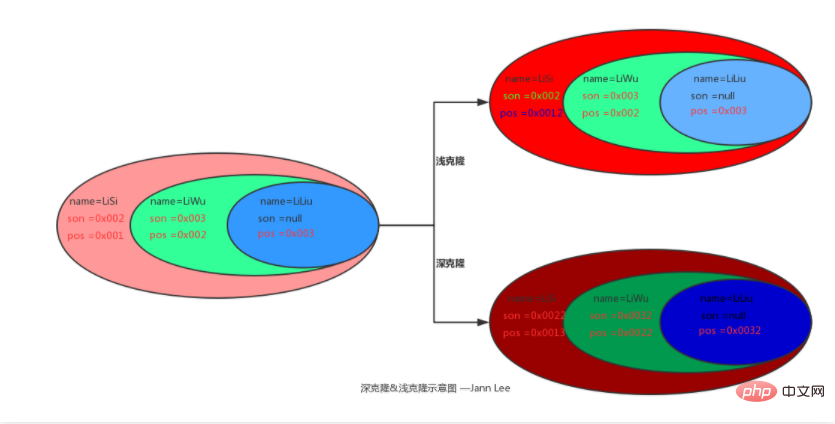 Java
Java
 JavaInterview questions
JavaInterview questions
 Talk about your understanding of deep cloning and shallow cloning in java
Talk about your understanding of deep cloning and shallow cloning in java
Talk about your understanding of deep cloning and shallow cloning in java

Alibaba interviewer question:
Talk about your understanding of deep cloning and shallow cloning in java
Answer:
(Note: This article is about the difference and implementation method between deep cloning and shallow cloning?)
Talk is cheap
#I have encountered deep and shallow cloning (deep copy, shallow copy) more than once recently Question, except for the impression that there is a clone method, I am confused! ! ! Cloning (copying) is a common operation in Java to quickly obtain a copy of an object. Cloning is divided into deep cloning and shallow cloning.
Shallow clone: Create a new object. The properties of the new object are exactly the same as the original object. For non-basic type properties, they still point to the memory address of the object pointed to by the original properties.
Deep cloning: Create a new object, and other objects referenced in the attributes will also be cloned and no longer point to the original object address.
In short, both deep and shallow cloning will allocate a new area in the heap. The difference lies in whether the object referenced by the object attribute needs to be cloned (recursively).
Show you my picture
#pos: the address of the current object;
son: the address pointed to by the son attribute;
name: the name of the object Attributes.

(Related recommendations: java introductory tutorial)
Show you my code
#case1:
public class Son implements Serializable , Cloneable{ private String name; private Son son; public Son() { super();
} public String getName() { return name;
} public void setName(String name) { this.name = name;
} public Son getSon() { return son;
} public void setSon(Son son) { this.son = son;
} @Override
public String toString() { return super.toString();
} @Override
protected Object clone() throws CloneNotSupportedException { return super.clone();
}
}Test
public static void main(String[] args) throws Exception{ // 创建父亲(LiLiu),儿子(LiWu),孙子(LiLiu)并关联
Son father = new Son();
father.setName("LiSi");
Son son = new Son();
son.setName("LiWu");
Son grandSon = new Son();
grandSon.setName("LiLiu");
father.setSon(son);
son.setSon(grandSon); // 调用clone方法
Son fatherCopy = (Son) father.clone(); boolean flag1 = fatherCopy==father; boolean flag2 = fatherCopy.getSon() == son; boolean flag3 = fatherCopy.getSon().getSon() == grandSon; // 比较克隆后的地址
System.out.println(flag1);// false
System.out.println(flag2);// true
System.out.println(flag3);// true
// 比较Name
flag1= fatherCopy.getName()==father.getName();
flag2 = fatherCopy.getSon().getName() == son.getName();
flag3 = fatherCopy.getSon().getSon().getName() == grandSon.getName();
System.out.println(flag1);// true
System.out.println(flag2);// true
System.out.println(flag3);// true
//将对象写到流里
ByteArrayOutputStream byteOut=new ByteArrayOutputStream();
ObjectOutputStream objOut=new ObjectOutputStream(byteOut);
objOut.writeObject(father); //从流里读出来
ByteArrayInputStream byteIn=new ByteArrayInputStream(byteOut.toByteArray());
ObjectInputStream objInput=new ObjectInputStream(byteIn);
fatherCopy = (Son) objInput.readObject();
flag1= fatherCopy==father;
flag2 = fatherCopy.getSon() == son;
flag3 = fatherCopy.getSon().getSon() == grandSon;
System.out.println(flag1);// false
System.out.println(flag2);// false
System.out.println(flag3);// false
// 比较Name
flag1= fatherCopy.getName()==father.getName();
flag2 = fatherCopy.getSon().getName() == son.getName();
flag3 = fatherCopy.getSon().getSon().getName() == grandSon.getName();
System.out.println(flag1);// false
System.out.println(flag2);// false
System.out.println(flag3);// false}It is easy to see from the above code and running results that if the object implements Cloneable and overrides the clone method without performing any operations, calling clone is a shallow clone. Using object streams to write objects to the stream and then read them out is deep cloning.
Thinking: Since implementing the Cloneable interface and rewriting the clone interface can only perform shallow cloning. However, if the reference type attributes of the class (and the reference type attributes of the attribute) are shallow cloned, until there is no reference type attribute or the reference type attribute is null, a deep clone will be formed as a whole. Both the reference type attribute of the object and the application type attribute of the attribute implement Coloneable, override the clone method and call it in the clone method.
protected Object clone() throws CloneNotSupportedException {
Son result = (Son) super.clone(); if (son != null) {
result.son = (Son) son.clone();
} return result;
}Personally, I think that when choosing the deep cloning method, it should be based on the complexity of the object, such as whether the reference type attribute has multiple layers of reference type attribute relationships. If the object has only one or two layers of reference type attributes, it is more convenient to choose the method mentioned in the reflection. Otherwise, use object flow.
For more related interview questions, please visit: java interview questions and answers
The above is the detailed content of Talk about your understanding of deep cloning and shallow cloning in java. For more information, please follow other related articles on the PHP Chinese website!

Hot AI Tools

Undresser.AI Undress
AI-powered app for creating realistic nude photos

AI Clothes Remover
Online AI tool for removing clothes from photos.

Undress AI Tool
Undress images for free

Clothoff.io
AI clothes remover

Video Face Swap
Swap faces in any video effortlessly with our completely free AI face swap tool!

Hot Article

Hot Tools

Notepad++7.3.1
Easy-to-use and free code editor

SublimeText3 Chinese version
Chinese version, very easy to use

Zend Studio 13.0.1
Powerful PHP integrated development environment

Dreamweaver CS6
Visual web development tools

SublimeText3 Mac version
God-level code editing software (SublimeText3)

Hot Topics
 Java Spring Interview Questions
Aug 30, 2024 pm 04:29 PM
Java Spring Interview Questions
Aug 30, 2024 pm 04:29 PM
In this article, we have kept the most asked Java Spring Interview Questions with their detailed answers. So that you can crack the interview.
 Break or return from Java 8 stream forEach?
Feb 07, 2025 pm 12:09 PM
Break or return from Java 8 stream forEach?
Feb 07, 2025 pm 12:09 PM
Java 8 introduces the Stream API, providing a powerful and expressive way to process data collections. However, a common question when using Stream is: How to break or return from a forEach operation? Traditional loops allow for early interruption or return, but Stream's forEach method does not directly support this method. This article will explain the reasons and explore alternative methods for implementing premature termination in Stream processing systems. Further reading: Java Stream API improvements Understand Stream forEach The forEach method is a terminal operation that performs one operation on each element in the Stream. Its design intention is
 TimeStamp to Date in Java
Aug 30, 2024 pm 04:28 PM
TimeStamp to Date in Java
Aug 30, 2024 pm 04:28 PM
Guide to TimeStamp to Date in Java. Here we also discuss the introduction and how to convert timestamp to date in java along with examples.
 Java Program to Find the Volume of Capsule
Feb 07, 2025 am 11:37 AM
Java Program to Find the Volume of Capsule
Feb 07, 2025 am 11:37 AM
Capsules are three-dimensional geometric figures, composed of a cylinder and a hemisphere at both ends. The volume of the capsule can be calculated by adding the volume of the cylinder and the volume of the hemisphere at both ends. This tutorial will discuss how to calculate the volume of a given capsule in Java using different methods. Capsule volume formula The formula for capsule volume is as follows: Capsule volume = Cylindrical volume Volume Two hemisphere volume in, r: The radius of the hemisphere. h: The height of the cylinder (excluding the hemisphere). Example 1 enter Radius = 5 units Height = 10 units Output Volume = 1570.8 cubic units explain Calculate volume using formula: Volume = π × r2 × h (4
 PHP: A Key Language for Web Development
Apr 13, 2025 am 12:08 AM
PHP: A Key Language for Web Development
Apr 13, 2025 am 12:08 AM
PHP is a scripting language widely used on the server side, especially suitable for web development. 1.PHP can embed HTML, process HTTP requests and responses, and supports a variety of databases. 2.PHP is used to generate dynamic web content, process form data, access databases, etc., with strong community support and open source resources. 3. PHP is an interpreted language, and the execution process includes lexical analysis, grammatical analysis, compilation and execution. 4.PHP can be combined with MySQL for advanced applications such as user registration systems. 5. When debugging PHP, you can use functions such as error_reporting() and var_dump(). 6. Optimize PHP code to use caching mechanisms, optimize database queries and use built-in functions. 7
 PHP vs. Python: Understanding the Differences
Apr 11, 2025 am 12:15 AM
PHP vs. Python: Understanding the Differences
Apr 11, 2025 am 12:15 AM
PHP and Python each have their own advantages, and the choice should be based on project requirements. 1.PHP is suitable for web development, with simple syntax and high execution efficiency. 2. Python is suitable for data science and machine learning, with concise syntax and rich libraries.
 Create the Future: Java Programming for Absolute Beginners
Oct 13, 2024 pm 01:32 PM
Create the Future: Java Programming for Absolute Beginners
Oct 13, 2024 pm 01:32 PM
Java is a popular programming language that can be learned by both beginners and experienced developers. This tutorial starts with basic concepts and progresses through advanced topics. After installing the Java Development Kit, you can practice programming by creating a simple "Hello, World!" program. After you understand the code, use the command prompt to compile and run the program, and "Hello, World!" will be output on the console. Learning Java starts your programming journey, and as your mastery deepens, you can create more complex applications.
 How to Run Your First Spring Boot Application in Spring Tool Suite?
Feb 07, 2025 pm 12:11 PM
How to Run Your First Spring Boot Application in Spring Tool Suite?
Feb 07, 2025 pm 12:11 PM
Spring Boot simplifies the creation of robust, scalable, and production-ready Java applications, revolutionizing Java development. Its "convention over configuration" approach, inherent to the Spring ecosystem, minimizes manual setup, allo





